Regulatory Role of GgaR (YegW) for Glycogen Accumulation in Escherichia coli K-12
Abstract
1. Introduction
2. Materials and Methods
2.1. E. coli Strains and Plasmids
2.2. ChIP-Chip Analysis
2.3. Purification of the GgaR Protein
2.4. Gel Shift Assay
2.5. Northern Blot Analysis
2.6. Observation and Measurement of Glycogen
2.7. Biofilm Formation Assay
2.8. Starvation Viability Assay
2.9. Real-Time (RT)-qPCR Analysis
2.10. Western Blot Analysis
3. Results
3.1. Search for GgaR-Binding Locations Using ChIP-Chip Screening
3.2. Confirmation of GgaR-Binding to Its Targets
3.3. Regulatory Role of GgaR in the Expression of the Target Genes
3.4. Effect of GgaR on Glycogen Accumulation
3.5. The Influence of GgaR under Stress Conditions
3.6. Search for Effectors Controlling GgaR Activity
3.7. Physiological Role of GgaR on E. coli Growth and Glycogen Accumulation in Minimal Medium
3.8. Protein Expression Level of GgaR Is Constant in Growth Phase
4. Discussion
Supplementary Materials
Author Contributions
Funding
Data Availability Statement
Acknowledgments
Conflicts of Interest
References
- Preiss, J.; Yung, S.; Baecker, P.A. Regulation of bacterial glycogen synthesis. Mol. Cell Biochem. 1983, 57, 61–80. [Google Scholar] [CrossRef] [PubMed]
- Preiss, J. Bacterial glycogen synthesis and its regulation. Annu. Rev. Microbiol. 1984, 38, 419–458. [Google Scholar] [CrossRef] [PubMed]
- Preiss, J.; Romeo, T. Physiology, biochemistry and genetics of bacterial glycogen synthesis. Adv. Microb. Physiol. 1989, 30, 183–238. [Google Scholar] [PubMed]
- Yamamotoya, T.; Dose, H.; Tian, Z.; Fauré, A.; Toya, Y.; Honma, M.; Igarashi, K.; Nakahigashi, K.; Soga, T.; Mori, H.; et al. Glycogen is the primary source of glucose during the lag phase of E. coli proliferation. Biochim. Biophys. Acta 2012, 1824, 1442–1448. [Google Scholar] [CrossRef] [PubMed]
- Wang, M.; Liu, Q.; Kang, X.; Zhu, Z.; Yang, H.; Xi, X.; Zhang, X.; Du, Y.; Guo, M.; Tang, D.; et al. Glycogen metabolism impairment via single gene mutation in the glgBXCAP operon alters the survival rate of Escherichia coli under various environmental stresses. Front. Microbiol. 2020, 11, 588099. [Google Scholar] [CrossRef] [PubMed]
- Romeo, T.; Kumar, A.; Preiss, J. Analysis of the Escherichia coli glycogen gene cluster suggests that catabolic enzymes are encoded among the biosynthetic genes. Gene 1988, 70, 363–376. [Google Scholar] [CrossRef]
- Preiss, J. Glycogen: Biosynthesis and regulation. EcoSal Plus 2014, 6, ESP-0015-2014. [Google Scholar] [CrossRef]
- Greenberg, E.; Preiss, J. The occurrence of adenosine diphosphate glucose: Glycogen transglucosylase in bacteria. J. Biol. Chem. 1964, 239, 4314–4315. [Google Scholar] [CrossRef]
- Dietzler, D.N.; Leckie, M.P.; Lais, C.J.; Magnani, J.L. Evidence for the allosteric regulation of bacterial glycogen synthesis in vivo. Arch. Biochem. Biophys. 1974, 162, 602–606. [Google Scholar] [CrossRef]
- Ballicora, M.A.; Iglesias, A.A.; Preiss, J. ADP-glucose pyrophosphorylase: A regulatory enzyme for bacterial glycogen synthesis. Microbiol. Mol. Biol. Rev. 2003, 67, 213–225. [Google Scholar] [CrossRef]
- Romeo, T.; Preiss, J. Genetic regulation of glycogen biosynthesis in Escherichia coli: In vitro effects of cyclic AMP and guanosine 5′-diphosphate 3′-diphosphate and analysis of in vivo transcripts. J. Bacteriol. 1989, 171, 2773–2782. [Google Scholar] [CrossRef] [PubMed]
- Hengge-Aronis, R.; Fischer, D. Identification and molecular analysis of glgS, a novel growth-phase-regulated and rpoS-dependent gene involved in glycogen synthesis in Escherichia coli. Mol. Microbiol. 1992, 6, 1877–1886. [Google Scholar] [CrossRef] [PubMed]
- Montero, M.; Almagro, G.; Eydallin, G.; Viale, A.M.; Munoz, F.J.; Bahaji, A.; Li, J.; Rahimpour, M.; Baroja-Fernandez, E.; Pozueta-Romero, J. Escherichia coli glycogen genes are organized in a single glgBXCAP transcriptional unit possessing an alternative suboperonic promoter within glgC that directs glgAP expression. Biochem. J. 2011, 433, 107–117. [Google Scholar] [CrossRef] [PubMed]
- Romeo, T.; Gong, M.; Liu, M.Y.; Brun-Zinkernagel, A.M. Identification and molecular characterization of csrA, a pleiotropic gene from Escherichia coli that affects glycogen biosynthesis, gluconeogenesis, cell size, and surface properties. J. Bacteriol. 1993, 175, 4744–4755. [Google Scholar] [CrossRef]
- Almagro, G.; Viale, A.M.; Montero, M.; Munoz, F.J.; Baroja-Fernandez, E.; Mori, H.; Pozueta-Romero, J. A cAMP/CRP-controlled mechanism for the incorporation of extracellular ADP-glucose in Escherichia coli involving NupC and NupG nucleoside transporters. Sci. Rep. 2018, 8, 15509. [Google Scholar] [CrossRef]
- Eydallin, G.; Viale, A.M.; Morán-Zorzano, M.T.; Muñoz, F.J.; Montero, M.; Baroja-Fernández, E.; Pozueta-Romero, J. Genome-wide screening of genes affecting glycogen metabolism in Escherichia coli K-12. FEBS Lett. 2007, 581, 2947–2953. [Google Scholar] [CrossRef]
- Eydallin, G.; Montero, M.; Almagro, G.; Sesma, M.T.; Viale, A.M.; Muñoz, F.J.; Rahimpour, M.; Baroja-Fernández, E.; Pozueta-Romero, J. Genome-wide screening of genes whose enhanced expression affects glycogen accumulation in Escherichia coli. DNA Res. 2010, 17, 61–71. [Google Scholar] [CrossRef]
- Montero, M.; Eydallin, G.; Viale, A.M.; Almagro, G.; Muñoz, F.J.; Rahimpour, M.; Sesma, M.T.; Baroja-Fernández, E.; Pozueta-Romero, J. Escherichia coli glycogen metabolism is controlled by the PhoP-PhoQ regulatory system at submillimolar environmental Mg2+ concentrations, and is highly interconnected with a wide variety of cellular processes. Biochem. J. 2009, 424, 129–141. [Google Scholar] [CrossRef]
- Ishihama, A.; Shimada, T.; Yamazaki, Y. Transcription profile of Escherichia coli: Genomic SELEX search for regulatory targets of transcription factors. Nucleic Acids Res. 2016, 44, 2058–2074. [Google Scholar] [CrossRef]
- Ishihama, A.; Shimada, T. Hierarchy of transcription factor network in Escherichia coli K-12: H-NS-mediated silencing and Anti-silencing by global regulators. FEMS Microbiol. Rev. 2021, 45, fuab032. [Google Scholar] [CrossRef]
- Karp, P.D.; Paley, S.; Caspi, R.; Kothari, A.; Krummenacker, M.; Midford, P.E.; Moore, L.R.; Subhraveti, P.; Gama-Castro, S.; Tierrafria, V.H.; et al. The EcoCyc Database. EcoSal Plus 2023, 11, eesp00022023. [Google Scholar] [CrossRef] [PubMed]
- Tierrafría, V.H.; Rioualen, C.; Salgado, H.; Lara, P.; Gama-Castro, S.; Lally, P.; Gómez-Romero, L.; Peña-Loredo, P.; López-Almazo, A.G.; Alarcón-Carranza, G.; et al. RegulonDB 11.0: Comprehensive high-throughput datasets on transcriptional regulation in Escherichia coli K-12. Microb. Genom. 2022, 8, mgen000833. [Google Scholar] [CrossRef] [PubMed]
- Grainger, D.C.; Hurd, D.; Harrison, M.; Holdstock, J.; Busby, S.J.W. Studies of the distribution of Escherichia coli cAMP-receptor protein and RNA polymerase along the E. coli chromosome. Proc. Natl. Acad. Sci. USA 2005, 102, 17693–17698. [Google Scholar] [CrossRef] [PubMed]
- Shimada, T.; Ogasawara, H.; Ishihama, A. Genomic SELEX screening of regulatory targets of Escherichia coli transcription factors. Methods Mol. Biol. 2018, 1837, 49–69. [Google Scholar] [PubMed]
- Jain, D. Allosteric control of transcription in GntR family of transcription regulators: A structural overview. IUBMB Life 2015, 67, 556–563. [Google Scholar] [CrossRef]
- Shimada, T.; Ishihama, A.; Busby, S.J.W.; Granger, D.C. The Escherichia coli RutR transcription factor binds at targets within genes as well as intergenic regions. Nucleic Acids Res. 2008, 36, 3950–3955. [Google Scholar] [CrossRef]
- Datsenko, K.A.; Wanner, B.L. One-step inactivation of chromosomal genes in Escherichia coli K-12 using PCR products. Proc. Natl. Acad. Sci. USA 2000, 97, 6640–6645. [Google Scholar] [CrossRef]
- Baba, T.; Ara, T.; Hasegawa, M.; Takai, Y.; Okumura, Y.; Baba, M.; Datsenko, K.A.; Tomita, M.; Wanner, B.L.; Mori, H. Construction of Escherichia coli K-12 in-frame, single-gene knockout mutants: The Keio collection. Mol. Syst. Biol. 2006, 2, 2006.0008. [Google Scholar] [CrossRef]
- Govons, S.; Vinopal, R.; Ingraham, J.; Preiss, J. Isolation of mutants of Escherichia coli B altered in their ability to synthesize glycogen. J. Bacteriol. 1969, 97, 970–972. [Google Scholar] [CrossRef]
- Shimada, T.; Fujita, N.; Maeda, M.; Ishihama, A. Systematic search for the Cra-binding promoters using genomic SELEX system. Genes. Cells 2005, 10, 907–918. [Google Scholar] [CrossRef]
- Anzai, T.; Imamura, S.; Ishihama, A.; Shimada, T. Expanded roles of pyruvate-sensing PdhR in transcription regulation of the Escherichia coli K-12 genome: Fatty acid catabolism and cell motility. Microb. Genom. 2020, 6, mgen000442. [Google Scholar] [CrossRef] [PubMed]
- Anzai, T.; Kijima, K.; Fujimori, M.; Nakamoto, S.; Ishihama, A.; Shimada, T. Expanded roles of lactate-sensing LldR in transcription regulation of the Escherichia coli K-12 genome: Lactate utilisation and acid resistance. Microb. Genom. 2023, 9, mgen001015. [Google Scholar] [CrossRef] [PubMed]
- Iijima, H.; Watanabe, A.; Sukigara, H.; Iwazumi, K.; Shirai, T.; Kondo, A.; Osanai, T. Four-carbon dicarboxylic acid production through the reductive branch of the open cyanobacterial tricarboxylic acid cycle in Synechocystis sp. PCC 6803. Metab. Eng. 2021, 65, 88–98. [Google Scholar] [CrossRef]
- Shimada, T.; Katayama, Y.; Kawakita, S.; Ogasawara, H.; Nakano, M.; Yamamoto, K.; Ishihama, A. A novel regulator RcdA of the csgD gene encoding the master regulator of biofilm formation in Escherichia coli. MicrobiologyOpen 2012, 1, 381–394. [Google Scholar] [CrossRef] [PubMed]
- Shimada, T.; Furuhata, S.; Ishihama, A. The whole set of constitutive promoters for RpoN sigma factor and the regulatory role of its enhancer protein NtrC in Escherichia coli K-12. Microb. Genom. 2021, 7, mgen000653. [Google Scholar] [CrossRef] [PubMed]
- Shimada, T.; Bridier, A.; Briandet, R.; Ishihama, A. Novel roles of LeuO in transcription regulation of E. coli genome: Antagonistic interplay with the universal silencer H-NS. Mol. Microbiol. 2011, 82, 378–397. [Google Scholar] [CrossRef] [PubMed]
- Lacour, S.; Landini, P. SigmaS-dependent gene expression at the onset of stationary phase in Escherichia coli: Function of sigmaS-dependent genes and identification of their promoter sequences. J. Bacteriol. 2004, 186, 7186–7195. [Google Scholar] [CrossRef]
- Saier, M.H., Jr.; Reddy, V.S.; Tsu, B.V.; Ahmed, M.S.; Li, C.; Moreno-Hagelsieb, G. The Transporter Classification Database (TCDB): Recent advances. Nucleic Acids Res. 2016, 44, D372–D379. [Google Scholar] [CrossRef]
- Finn, R.D.; Coggill, P.; Eberhardt, R.Y.; Eddy, S.R.; Mistry, J.; Mitchell, A.L.; Potter, S.C.; Punta, M.; Qureshi, M.; Sangrador-Vegas, A.; et al. The Pfam protein families database: Towards a more sustainable future. Nucleic Acids Res. 2016, 44, D279–D285. [Google Scholar] [CrossRef]
- Ishihama, A. Molecular assembly and functional modulation of Escherichia coli RNA polymerase. Adv. Biophys. 1990, 26, 19–31. [Google Scholar] [CrossRef]
- Jishage, M.; Iwata, A.; Ueda, S.; Ishihama, A. Regulation of RNA polymerase sigma subunit synthesis in Escherichia coli: Intracellular levels of four species of sigma subunit under various growth conditions. J. Bacteriol. 1996, 178, 5447–5451. [Google Scholar] [CrossRef]
- Shimada, T.; Ogasawara, H.; Ishihama, A. Single-target regulators form a minor group of transcription factors in Escherichia coli K-12. Nucleic Acids Res. 2018, 46, 3921–3936. [Google Scholar] [CrossRef] [PubMed]
- Shimada, T.; Murayama, R.; Mashima, T.; Kawano, N.; Ishihama, A. Regulatory role of CsuR (YiaU) in determination of cell surface properties of Escherichia coli K-12. Microbiology 2022, 168, 001166. [Google Scholar] [CrossRef] [PubMed]
- Kobayashi, I.; Mochizuki, K.; Teramoto, J.; Imamura, S.; Takaya, K.; Ishihama, A.; Shimada, T. Transcription factors SrsR (YgfI) is a novel regulator for the stress-response genes in stationary phase in Escherichia coli K-12. Int. J. Mol. Sci. 2022, 23, 6055. [Google Scholar] [CrossRef] [PubMed]
- Shimada, T.; Ogasawara, H.; Kobayashi, I.; Kobayashi, N.; Ishihama, A. Single-target regulators constitute the minority group of transcription factors in Escherichia coli K-12. Front. Microbiol. 2021, 12, 697803. [Google Scholar] [CrossRef]
- Choi, P.; Cai, L.; Frieda, K.; Xie, X.S. A stochastic single-molecule event triggers phenotype switching of a bacterial cell. Science 2008, 322, 442–446. [Google Scholar] [CrossRef]
- Gayán, E.; Wang, Z.; Salvador, M.; Gänzle, M.G.; Aertsen, A. Dynamics of high hydrostatic pressure resistance development in RpoS-deficient Escherichia coli. Food Res. Int. 2023, 164, 112280. [Google Scholar] [CrossRef]

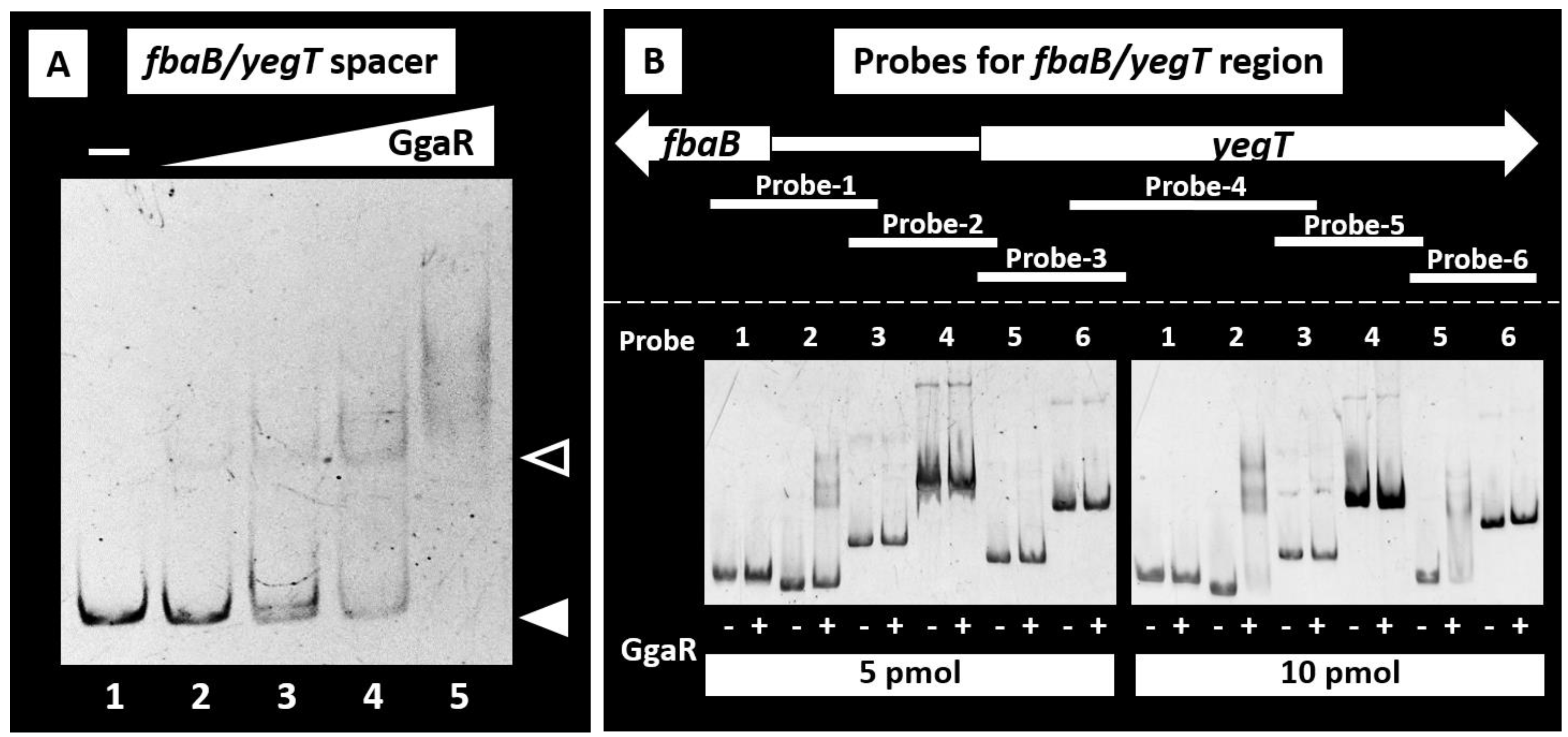

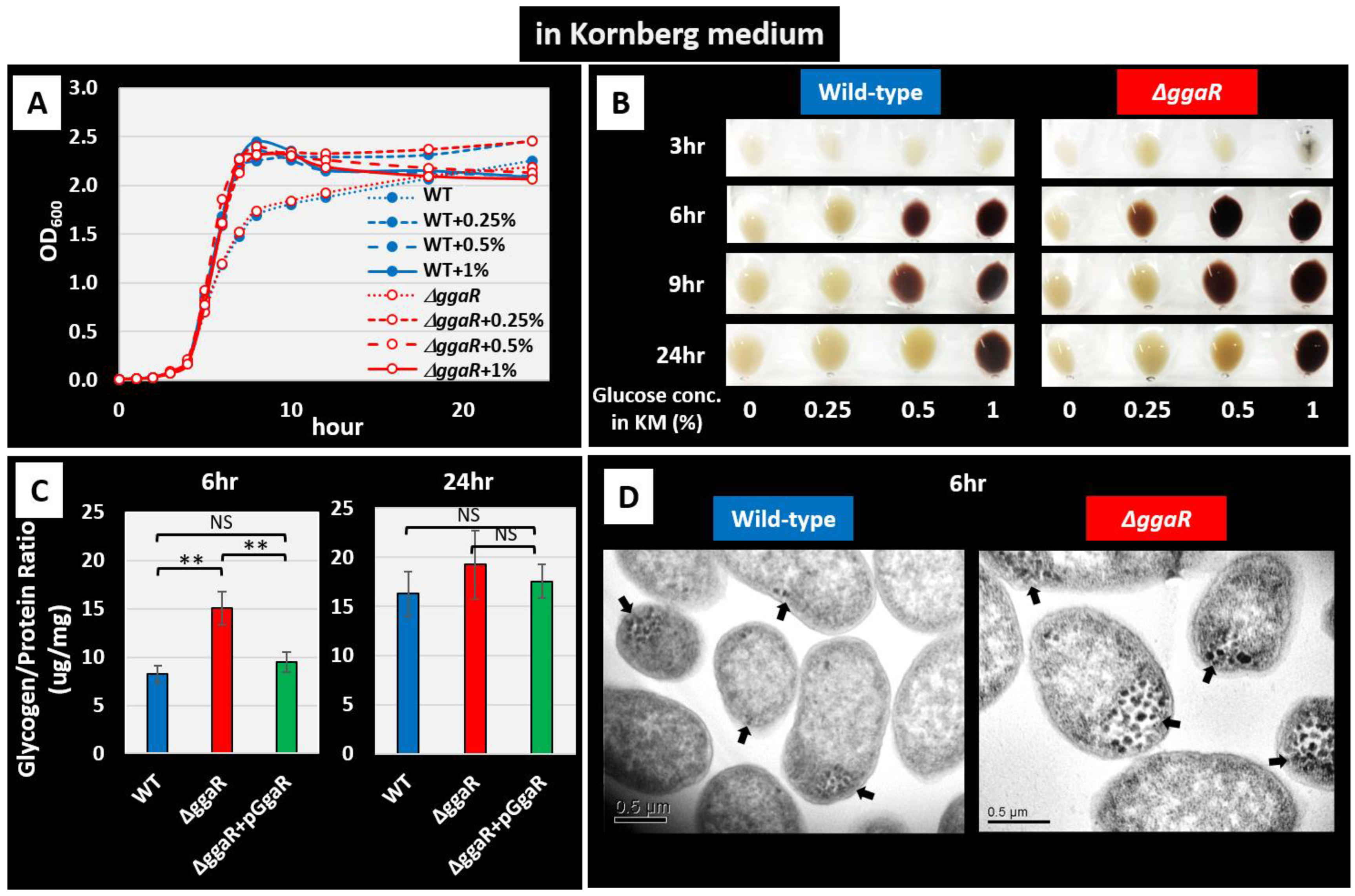
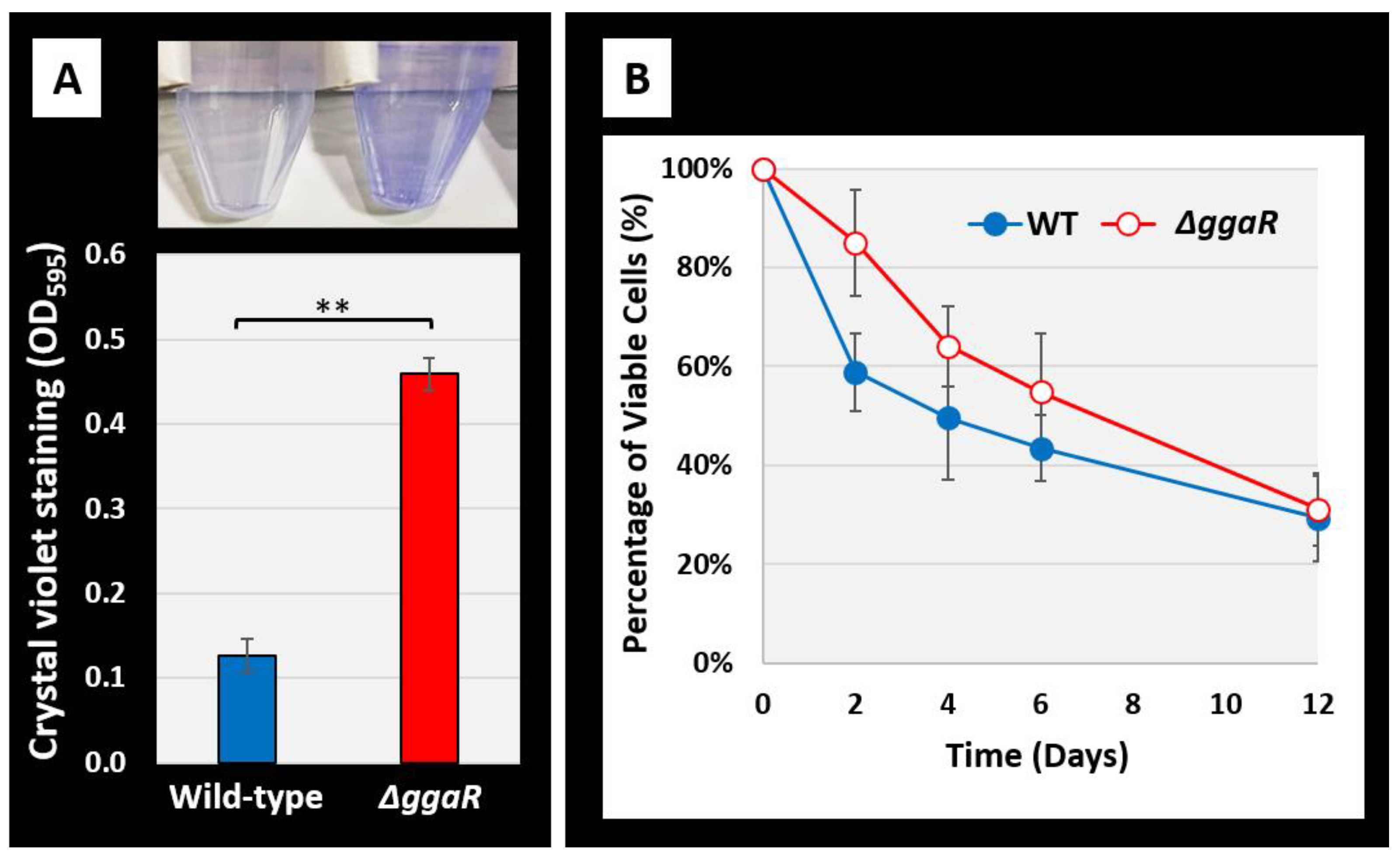
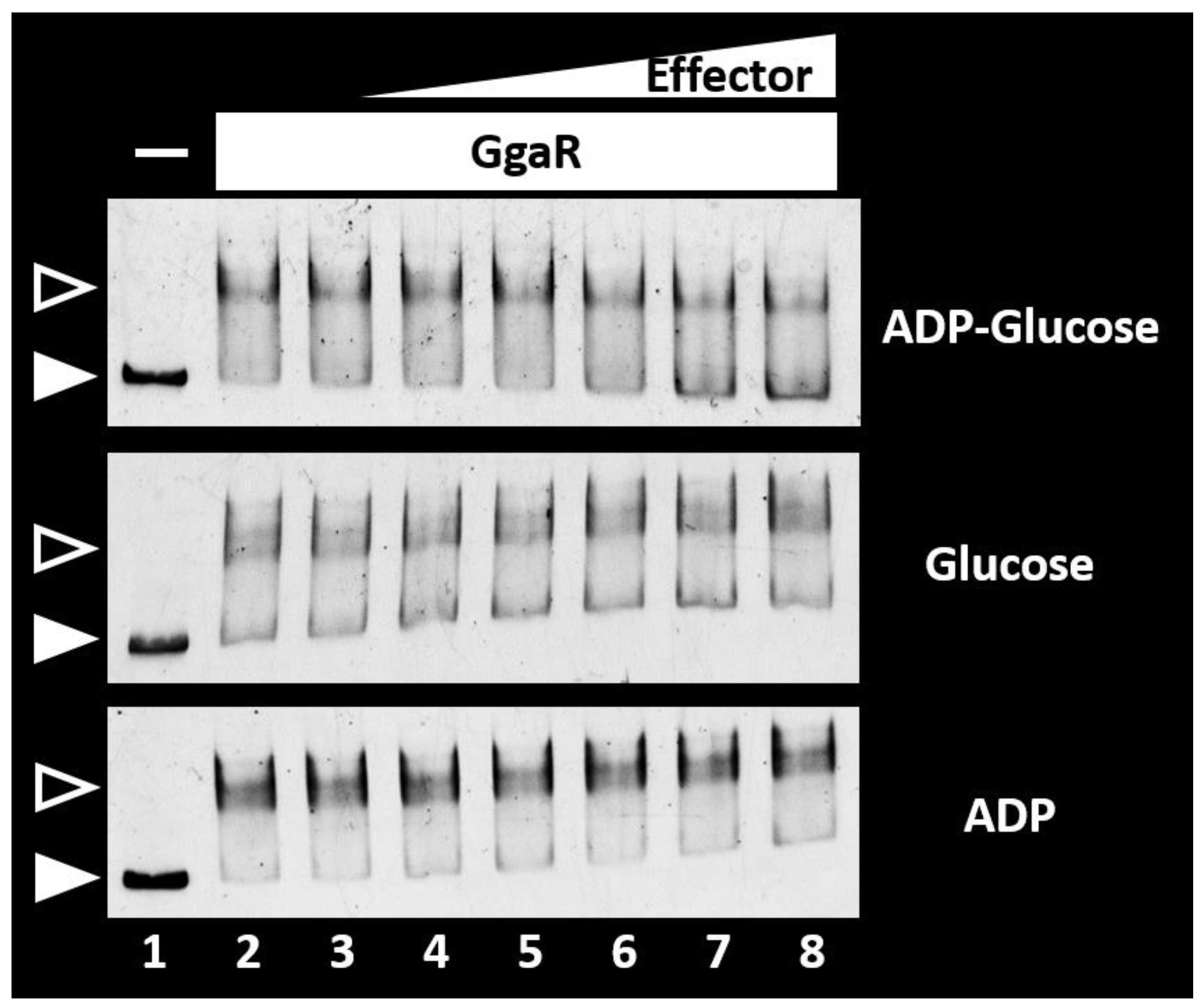
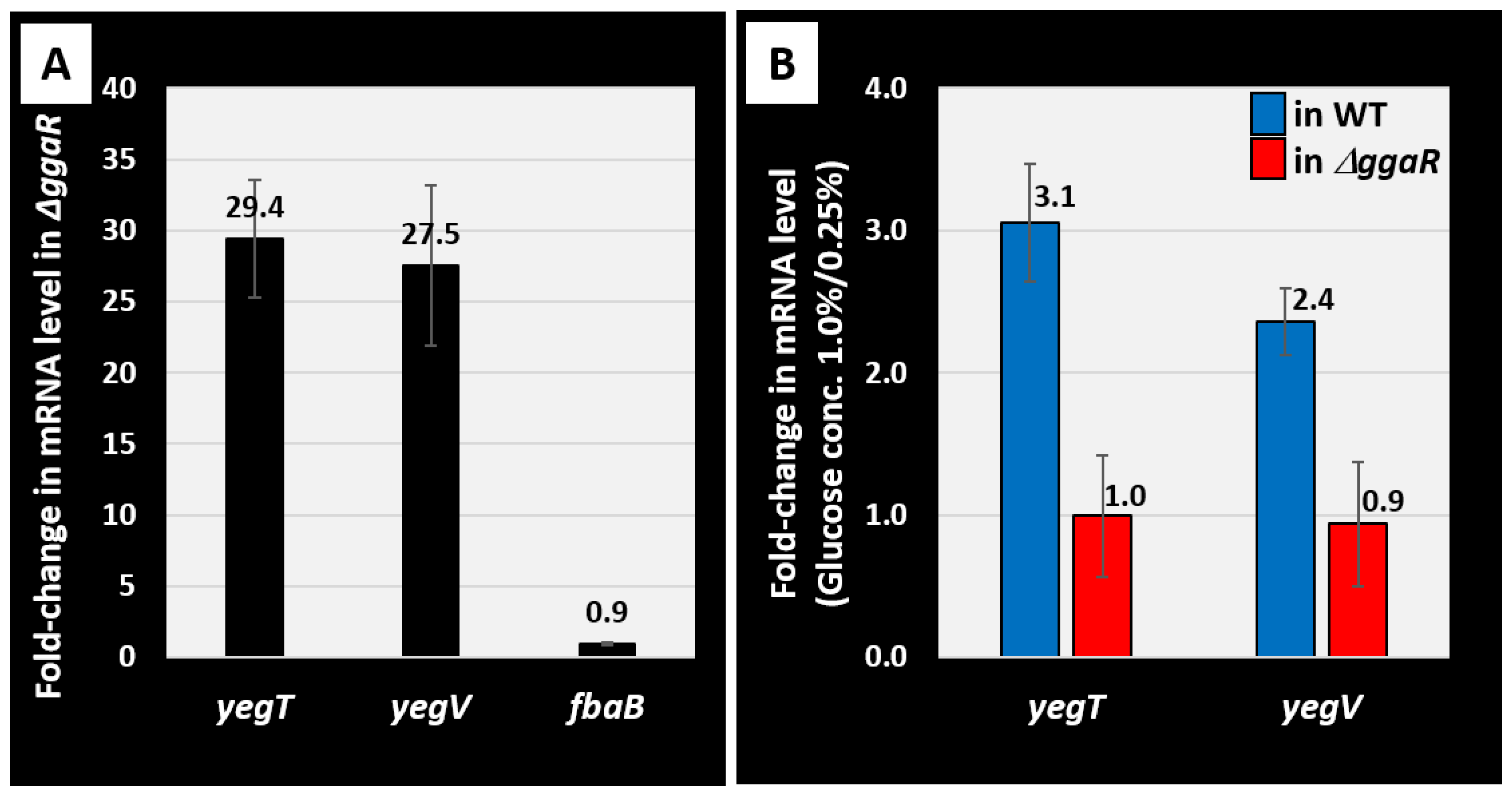
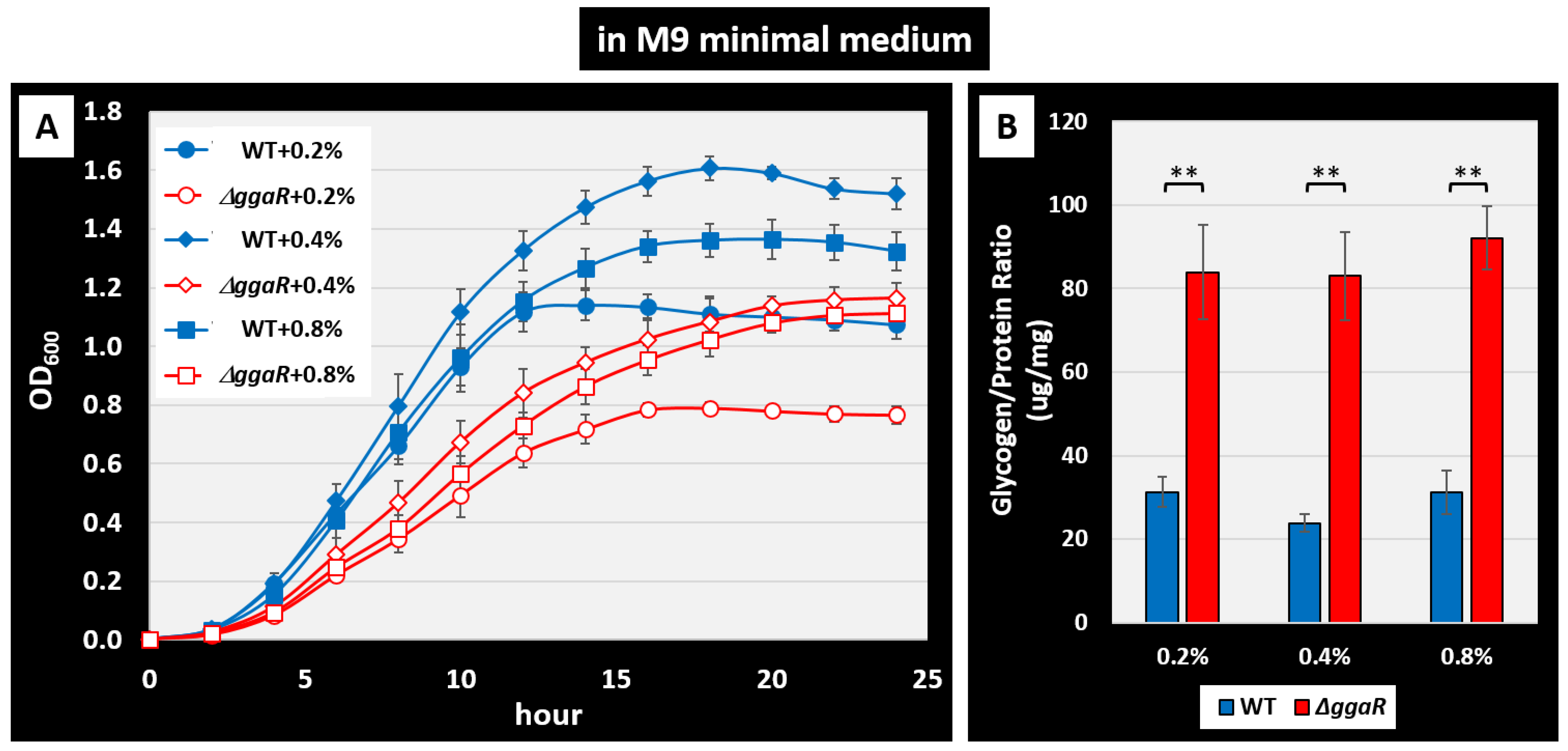

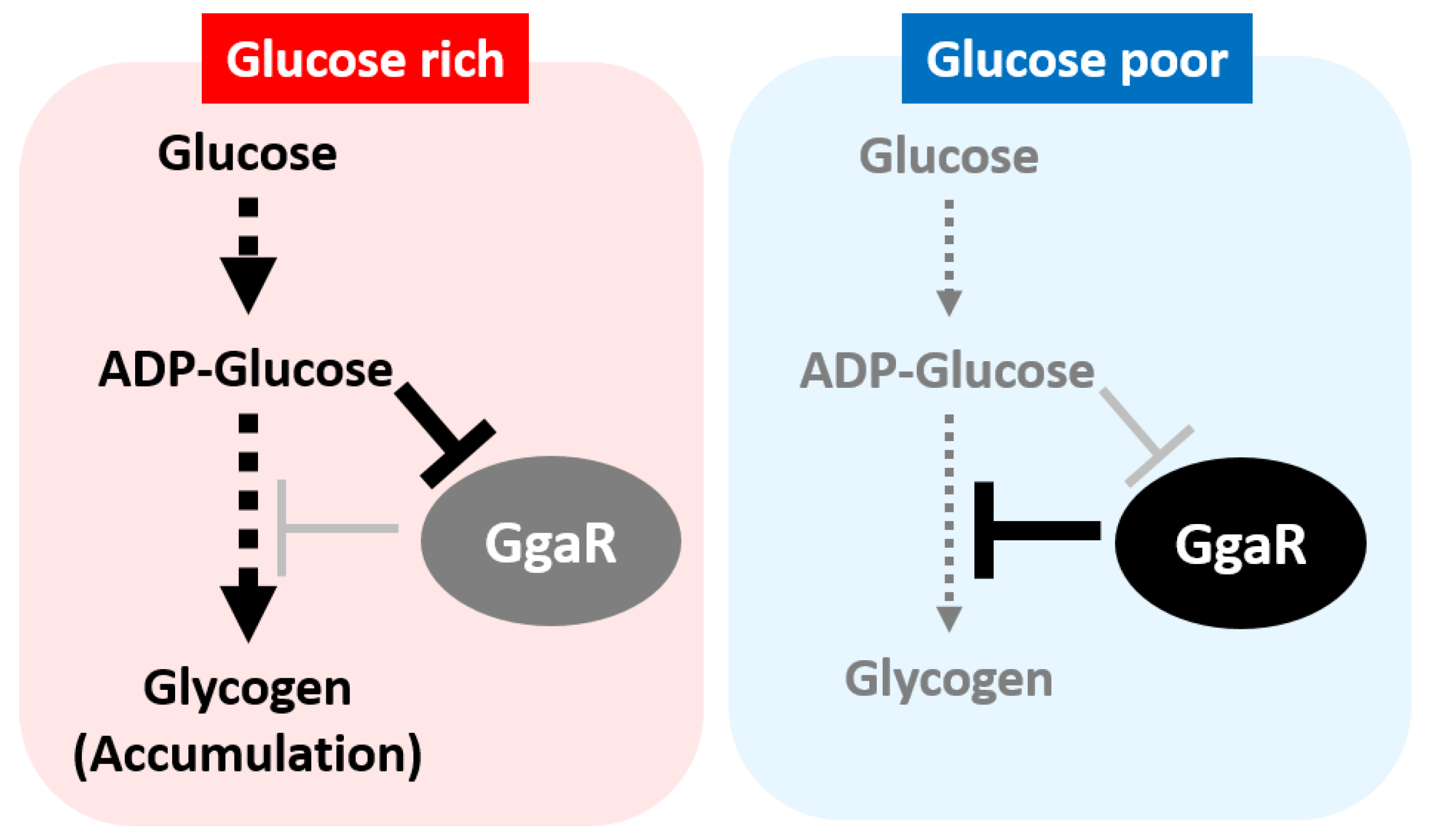
Disclaimer/Publisher’s Note: The statements, opinions and data contained in all publications are solely those of the individual author(s) and contributor(s) and not of MDPI and/or the editor(s). MDPI and/or the editor(s) disclaim responsibility for any injury to people or property resulting from any ideas, methods, instructions or products referred to in the content. |
© 2024 by the authors. Licensee MDPI, Basel, Switzerland. This article is an open access article distributed under the terms and conditions of the Creative Commons Attribution (CC BY) license (https://creativecommons.org/licenses/by/4.0/).
Share and Cite
Saito, S.; Kobayashi, I.; Hoshina, M.; Uenaka, E.; Sakurai, A.; Imamura, S.; Shimada, T. Regulatory Role of GgaR (YegW) for Glycogen Accumulation in Escherichia coli K-12. Microorganisms 2024, 12, 115. https://doi.org/10.3390/microorganisms12010115
Saito S, Kobayashi I, Hoshina M, Uenaka E, Sakurai A, Imamura S, Shimada T. Regulatory Role of GgaR (YegW) for Glycogen Accumulation in Escherichia coli K-12. Microorganisms. 2024; 12(1):115. https://doi.org/10.3390/microorganisms12010115
Chicago/Turabian StyleSaito, Shunsuke, Ikki Kobayashi, Motoki Hoshina, Emi Uenaka, Atsushi Sakurai, Sousuke Imamura, and Tomohiro Shimada. 2024. "Regulatory Role of GgaR (YegW) for Glycogen Accumulation in Escherichia coli K-12" Microorganisms 12, no. 1: 115. https://doi.org/10.3390/microorganisms12010115
APA StyleSaito, S., Kobayashi, I., Hoshina, M., Uenaka, E., Sakurai, A., Imamura, S., & Shimada, T. (2024). Regulatory Role of GgaR (YegW) for Glycogen Accumulation in Escherichia coli K-12. Microorganisms, 12(1), 115. https://doi.org/10.3390/microorganisms12010115






